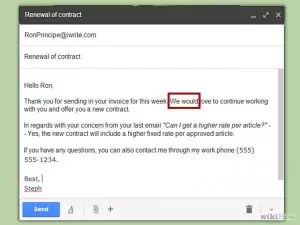
Business emails effectively help to coordinate efforts when working on projects and to inform or question employees. In order to make business correspondence through email more efficient, a number of rules should be observed. Abiding by these rules will not only help distinguish your emails from others in the recipient’s mailbox, but it will leave a positive impression on your business partners.
Steps for Writing a Business Email
- Compose a subject line that will reflect the content of the email. For example, if you are asking a subordinate to provide you with a monthly report a week in advance, you can title your email: “Monthly report deadline change.”
- Write the main body text. Usually, a business email is no longer than two or three paragraphs. Don’t include any personal information.
- Attach all documents you need to send with the email, assign CCs if needed, and insert hyperlinks to important information not included in your email.
- Insert the electronic address of your recipient. This is done to avoid situations when the email is sent to a wrong correspondent, or when you accidentally send a draft or an unfinished letter.
- Proofread your email. Check to see if the hyperlinks work. Also, scan the attachments with antivirus software and check whether all attached files open.
Remember, you can always get inspiration for your personal letter from outside sources. Check out any of the best assignment help services – you can find samples of similar texts there. Or, you can also use the websites’ assistance to create that business email from scratch.
Topic Selection
A business topic for an email usually refers to an urgent matter, an upcoming meeting, the introduction of new employees, new tasks, a document that needs to be sent, and so on. Each email should refer to only one topic. The topic is often reflected in the subject line. Therefore, it should represent the topic specifically, otherwise the recipient can miss important information due to ignoring an email with a strange title.
Key Points to Consider
- A business email is a less formal type of writing compared to a paper letter. You don’t have to observe all the rules that a written letter should comply with. Business emails are also more concise—information contained in them should be straight to the point.
- One business email letter should be written on just one topic. Accuracy in such details will make the correspondence easier to maintain, since all the letters in the chain will refer to the same topic.
- The address of the mailbox used to send the email to your business partners matters. The email address should be easy to spell and easy to remember. Also, it must be noteworthy. The best option for an email address is to use your first name, initials, and your last name.
- When an electronic copy of a document must be sent via email, copying the document’s contents and pasting it into the body of your email is not a sound idea. Reading long expanses of text right from the mailbox is tiring. Instead, attach the document you want to send as a separate file.
Do and Don’t
Do
|
Don’t
|
Common Mistakes When Writing a Business Email
– Self-promoting oneself heavily. If your business partners receive an email with details of how significant your position is and how great the company is that you work for, they will most likely stop reading the entire letter.
– Forgetting to fill in the subject line or making it too vague.
– Sending an email with text that is not divided into parts. If the text of your email is lengthy, it is a sound idea to break it into subsections, each with its own heading, and create bulleted lists so the recipient can navigate through the email more efficiently.
– Forgetting to attach files or copying the content of the to-send document and pasting it into the body of the email.
Follow us on Reddit for more insights and updates.



Comments (0)
Welcome to A*Help comments!
We’re all about debate and discussion at A*Help.
We value the diverse opinions of users, so you may find points of view that you don’t agree with. And that’s cool. However, there are certain things we’re not OK with: attempts to manipulate our data in any way, for example, or the posting of discriminative, offensive, hateful, or disparaging material.